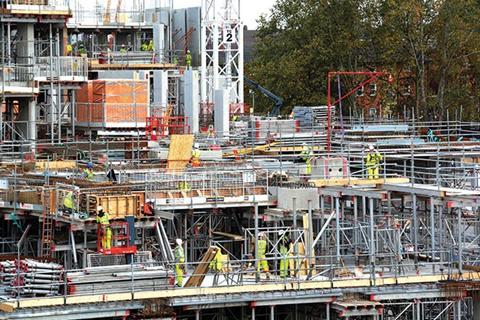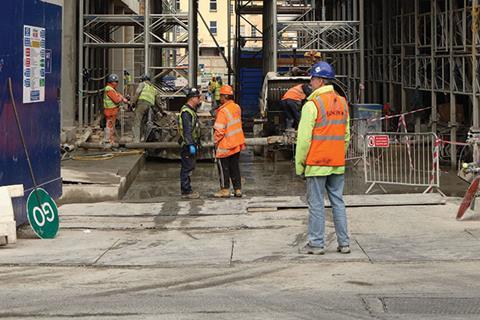The government’s pledge to deliver 3 million apprenticeships through a levy on large employers has left many in the industry confused as to how the policy will work with construction’s own scheme funded through the CITB. David Blackman outlines the possible options

It’s undoubtedly a bold vision, but one that some fear could be a recipe for chaos: the Conservatives have pledged to deliver 3 million apprenticeships over the lifetime of the current parliament. That’s 600,000 each year, compared to just 250,000 each year currently being achieved.
While the details so far are sketchy to say the least, chancellor George Osborne’s July Budget outlined a proposal for a levy on large UK employers to fund this new wave of apprenticeships.
The government’s productivity plan, called Fixing the Foundations and published shortly after the Budget, made clear the government’s approach is heavily influenced by the findings of a recently published study by the Social Market Foundation (SMF) (see box, below).
It says firms will be able to recoup levy payments if they train sufficient apprentices – such economy-wide levies already exist in more than 50 other countries, including Germany, France and Denmark, according to the productivity plan.
Building on existing proposals, employers will be able, in theory, to secure the training they need by using digital vouchers to shop around for training providers. The government’s drive to boost apprenticeships will be welcome in those sectors which have no specific structure to fund and organise on-the-job training.
The construction industry, though, is one of the few sectors to already have a levy system to support apprenticeships. However, the Construction Industry Training Board (CITB), the body that oversees the sector’s training arrangements, attracts plenty of criticism – with the levy detested by many small firms that say it is difficult to get support back from the CITB.
With Osborne committing to introduce this cross-industry levy on large employers, questions are already being asked over whether this spells the end for the construction-only scheme, and if not, whether building firms will be hit twice with a tax on training.
Sarah McMonagle, head of external affairs at the Federation of Master Builders (FMB), says the scale of the challenge is huge. “If 3 million apprentices are to be delivered over the next five years, 200,000 will have to be delivered by construction, on the basis that it accounts for 7% of GDP. That’s 42,000 a year compared to 16,000 now, so we need to crank it up quite significantly if we are going to get anywhere close,” she says.
“If the truth be told it [the system] is not really working at the moment. We completely understand the government’s desire to take a fresh look at this to see what might work better.”
The industry’s own endemic skills crisis offers an even more pressing reason for construction to boost apprenticeships. The CBI’s annual education and skills survey, published earlier this month, reported that three-quarters of construction firms expect strong demand for highly skilled workers, the highest proportion for any industry sector surveyed by the CBI.
But many fear that the wide-ranging reforms being prepared by the government will plunge the industry’s training system into chaos just when demand for skilled staff is exploding.
So what are the options for the construction industry as the government embarks on its apprenticeships revolution?
The SMF report
The government’s proposed shake-up of apprenticeship policy is clearly influenced by a report recently published by the Social Market Foundation (SMF), a centrist think tank – which was directly referenced in the Fixing the Foundations productivity plan.
The SMF’s key recommendation is the establishment of a national apprenticeship levy, the main features of which are:
- Every employer pays in via a small levy on payroll, similar to taxes in other EU countries, such as France and Austria
- Firms employing apprentices would be subsidised by the fund
- The apprentice’s employer would select where training took place from an approved list of institutions.
OPTION 1: Keeping the CITB levy and exempting construction firms from paying the new levy
This approach won most favour among those firms contacted by Building as it will avoid the widespread disruption which abolition could bring in its wake.
Michael Smyth, HR director of Graham Construction, says: “There needs to be a centralised source that the industry can look towards, defining what we are doing.”
Nigel Brook, Kier executive director, construction and infrastructure, agrees: “If a new levy is created, it would be wiser to channel that funding back into an established partner like the CITB to create more informed and immediate delivery, against whatever targets are set.”
However, this approach should not give the CITB “carte blanche” to carry on exactly as it is, argues David Frise, chief executive of the Finishes and Interiors Sector (FIS), which was created last year from a combination of the associations representing interior specialists and plastering and drywall contractors . If it survives, the industry’s training body will have to sharpen up its act, he says: “We want to see quicker and bolder reform. Our vision is of a levy system that is more efficiently collected, and a grant system that is easy and simple to operate and reduces the level of bureaucracy and paperwork to a bare minimum.”
However, one of the problems identified by the SMF report is that companies whose workforces straddle a number of different industries have to negotiate different training regimes. The industry will have its work cut out convincing a government that is keen to axe unnecessary bureaucracies, that keeping its own arrangements makes sense.
OPTION 2: Abolishing the CITB levy and replacing it with the whole economy levy
If the new levy is rolled out across the economy, without special opt-outs for existing industry arrangements, the CITB could lose the income it receives from the sector’s large companies. Deprived of this levy income, the weakened industry training body would be hard-pressed to survive.
David Frise, chief executive of FIS, remembers the chaos that ensued when M&E contractors pulled out of the CITB levy scheme in the early 2000s. “I’ve seen the damage that caused: training dropped off the cliff for a while and we are still suffering from that,” he says. He fears the same upshot if the CITB is wound up. “There would inevitably be a period of chaos and uncertainty at a time when there is a massive skills shortage.
“We have something: it’s not perfect but it’s established. It’s better to reform something which is in place rather than start again.”
Another problem is that the government’s proposal for a levy only covers large companies, likely to be those employing 250 or more staff, which is the European Union’s definition. The CITB’s levy by contrast covers the whole industry. “The levy covers all sizes of business, which is different to what is being proposed,” says Gillian Econopouly, head of policy at the CITB.
“We are wondering where this leaves small employers,” says McMonagle. “Two-thirds of all construction apprentices are trained by micro-firms so we need to make sure that we get the training right in our part of the sector. Otherwise the whole thing will be jeopardised.” The FMB is carrying out research into the factors that put small firms off from undertaking training.
Econopouly agrees: “In some sectors, the large firm approach will deliver a lot of apprentices, but our data tells us that SMEs are going to be a critical source of growth (in construction) and they need to be catered for.”
Of the £129m of grants awarded in 2013-14 by the CITB, according to its annual report, nearly two-thirds went to small and medium-sized enterprises.
In addition, the CITB levy doesn’t just cover apprenticeships, but other forms of construction training, such as courses that lead to HND qualifications. Less than one-third of the £129m awarded by the CITB actually goes on supporting apprenticeships with the rest covering these other priorities.
As for any replacement system, cash is important but not sufficient. Any new arrangement would need to find ways to convince businesses that it is worth their while to invest time and effort on apprentices, which an industry-specific body is arguably best placed to do.
“Any new system needs employer buy-in and to be really clear. What’s provided has to be relevant,” says Econopouly. “If you don’t have industry buy-in, it can’t be successful. Industries need a clear idea of what they are getting out of it.”
Ian Wybron, the researcher from the think tank Demos, which ran the CITB’s recent apprenticeship commission, says: “A levy on its own is not going to make taking on an apprentice a certain option for all employers. This adds another moving part to an already complicated system.”

OPTION 3: Making construction firms pay both
The final approach would be for the government, if it is wedded to lumping all large firms into a cross-economy levy, to keep the CITB going, perhaps with a levy covering only smaller construction firms. Of the three options mooted here, this is the one that gets shortest shrift. McMonagle says this solution would be “complicated and messy”. Frise goes further, arguing that it “would be bureaucracy gone mad”. Chris Jones, director of learning & development at BAM, says: “We would be very reluctant to pay both.”
Kier’s Brook says: “Obviously we already have an industry-wide levy collected and administered by the CITB, so a key concern is going to be duplication, both in cost terms and in creating new layers of administration or new organisations designed to deliver apprenticeship activity.”
Should the two levies run side by side, Jones would be keen to establish which should take priority and whether it would be possible to offset the costs of one against the other.
He says: “We would have to have a conversation about making sure we get something in return.”



























No comments yet